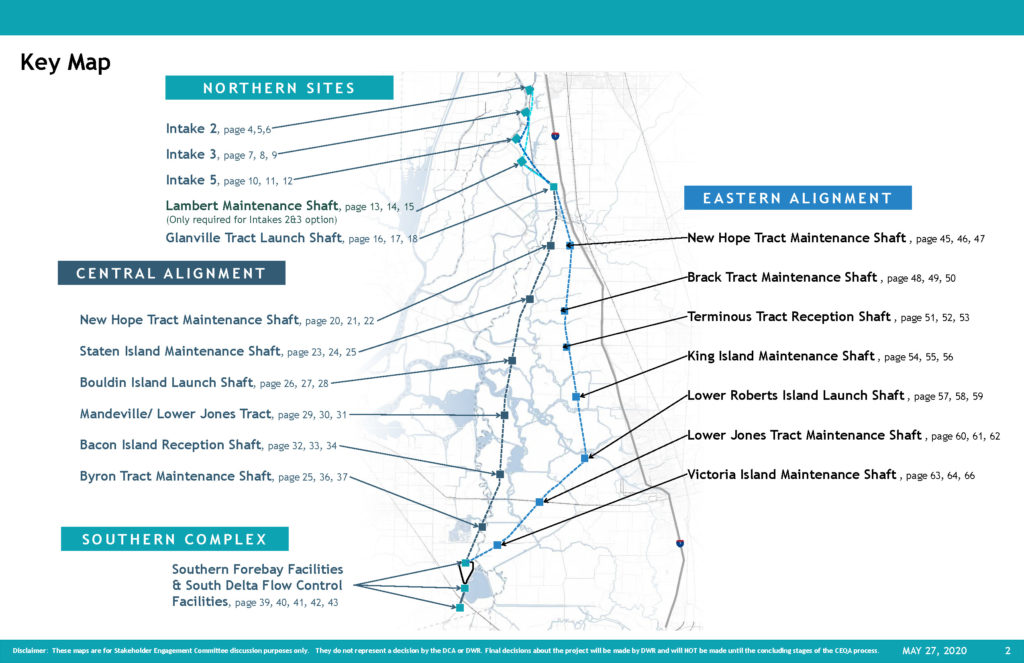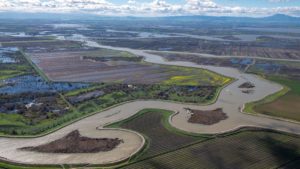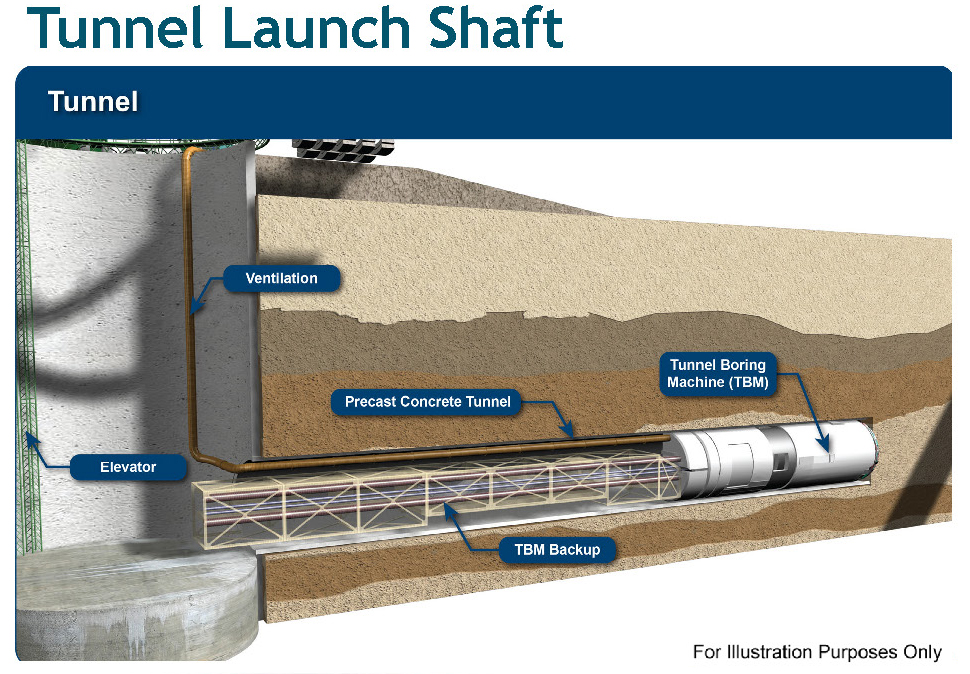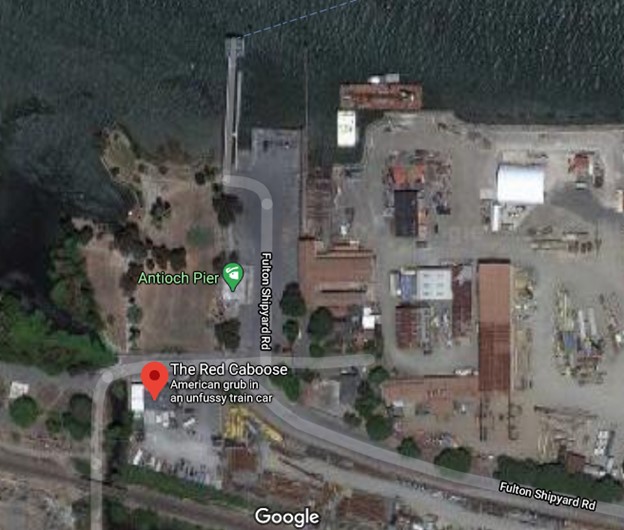
Proposed Delta Conveyance Project Facility Corridor Options. From Scoping Summary Report.
This week’s DCP Environmental Planning Update includes:
- Adoption of a Mitigated Negative Declaration and Approval of Soil Collection Activities
- Announcement of Federal Environmental Review
Delta Conveyance Project Scoping Summary Report Now Available
By Allen Payton

Photo by Department of Water Resources.
What was planned as two tunnels beneath the California Delta to divert fresh water from north of the Delta to areas south including as far away as the Municipal Water District serving Los Angeles, is now a single tunnel plan that is referred to as the Delta Conveyance Project (DCP). The state previously referred to the two tunnel project as the WaterFix.
Although the state Department of Water Resources (DWR) rescinded all approvals of the WaterFix twin tunnel project last year, the Delta Conveyance Design and Construction Authority continues engineering and geotechnical work on the single tunnel project under DWR’s supervision.
On May 2, 2019 the DWR announced it was taking formal steps to withdraw proposed permits for the WaterFix project and began a renewed environmental review and planning process for a smaller, single tunnel project that will protect a critical source of water supplies for California. Those actions implement Governor Gavin Newsom’s direction earlier in 2019, to modernize the state’s water delivery infrastructure by pursuing a smaller, single tunnel project through the Sacramento-San Joaquin Delta. The project will be designed to protect water supply reliability while limiting impacts on local Delta communities and fish. The actions also follow the governor’s executive order directing state agencies to develop a comprehensive statewide strategy to build a climate-resilient water system.
The purpose of the new DCP is “to develop new diversion and conveyance facilities in the Delta necessary to restore and protect the reliability of State Water Project (SWP) deliveries and, potentially, Central Valley Project (CVP) water deliveries south of the Delta, consistent with the State’s Water Resilience Portfolio [WRP].”
California Natural Resources Secretary Wade Crowfoot describes it as “A smaller project, coordinated with a wide variety of actions to strengthen existing levee protections, protect Delta water quality, recharge depleted groundwater reserves, and strengthen local water supplies across the state” that “will build California’s water supply resilience.”
The tunnel will be drilled 150 feet underground.

No Participation by Contra Costa Water Agencies
So, the effort to move fresh Delta water south, continues. But none of the water agencies in Contra Costa County are part of the DCA. They all either oppose or have chosen to remain neutral on the proposed tunnel in the face of almost complete opposition by county residents.
Instead, Contra Costa County is part of the five-member Delta Counties Coalition, along with Sacramento, San Joaquin, Solano and Yolo Counties all opposing the tunnel project.
However, there are four county residents who are members of the DCA’s Stakeholder Engagement Committee. Learn more about them, their opposition to the project and what they’re doing to limit and ensure the project mitigates any impact on county residents and businesses in Part 2 of this report.
The DCA participating state water contractors include the following agencies:
- Alameda County Water District (At Large)
- Alameda County Flood Control and Water Conservation District, Zone 7 (At Large)
- Antelope Valley-East Kern Water Agency (At Large)
- Coachella Valley Water District (At Large)
- Metropolitan Water District of Southern California (2 Permanent Seats)
- Mojave Water Agency (At Large)
- San Bernardino Valley Municipal Water District (At Large)
- San Gorgonio Pass Water Agency (At Large)
- Santa Clara Valley Water District (Permanent Seat)
DCA officers serve two-year terms. The SWC At Large Director and Alternate Director represent all participating State Water Contractors without a permanent Board seat. Directors and Alternate Directors are determined by the participating State Water Contractors. In addition, the Joint Powers Agreement allocates a Board seat to Kern County Water Agency. This seat is currently unfilled as Kern County Water Agency has not joined the DCA

Photo by California Dep’t of Water Resources.
$11 Billion Price Tag Could Quadruple
According to Barbara Barrigan-Parrilla, Executive Director of Restore the Delta, “the $11 billion figure quoted for construction of the Delta Conveyance Project is dated and incomplete. The $11 billion figure is in 2018 dollars. In 2018, Metropolitan Water District claimed inflation for construction should be calculated at 5% interest annually. That puts the project over $12 billion today without all the mitigation measures discussed by the Design Construction Authority in stakeholder meetings with Delta community members. These externalized mitigation costs will be absorbed by taxpayers.
Before bond interest, and with externalized mitigation costs, inflation roughly would put construction costs closer to $20 billion. Bond interest generally speaking would double the cost to $40 billion. And if the state is going to make Delta communities whole and leave the Delta ‘better off’ than it is presently, additional billions of dollars would need to be spent.”
Impact on Antioch
For Antioch, which has pre-1914 rights to water and can take as much from the river as it needs, and has the lowest intake in the entire Delta, the result will be greater saltwater intrusion, as there will be less pressure from the fresh water flowing through the Delta. In response, the City of Antioch has approved the construction of a $60 million desalination plant. (See related article)
Latest Updates & Reports
This week, the DWR issued an update and scoping report on environmental planning for the single tunnel project.
DWR Adopts Mitigated Negative Declaration and Approves Soil Collection Activities
Today, Thursday, July 9, 2020, consistent with the requirements of the California Environmental Quality Act (CEQA), the Department of Water Resources (DWR) adopted the Final Initial Study/Mitigated Negative Declaration (IS/MND) for soil investigations in the Sacramento-San Joaquin Delta (Delta). As part of the CEQA process, DWR also formally approved the action and adopted a Mitigation Monitoring and Reporting Plan (MMRP). Soil investigations will include data collection, soil samples and surveys in support of DWR’s efforts to better understand the region’s geology to support the future evaluation of potential activities, including the proposed Delta Conveyance Project. As identified in the Final IS/MND, any potential significant impact will be avoided or otherwise mitigated with implementation of mitigation adopted as part of the project approval process. To access a copy of the Notice of Determination and Final IS/MND, which includes responses to comments and the adopted MMRP, visit the Delta Conveyance Environmental Planning page on DWR’s website.
U.S. Army Corps of Engineers to Prepare an Environmental Impact Statement Under the National Environmental Policy Act
The U.S. Army Corps of Engineers (USACE) has informed DWR that it will conduct federal environmental review of the proposed Delta Conveyance Project. USACE, which has regulatory authority over certain actions within specifically defined waters in the United States, will prepare an Environmental Impact Statement (EIS) under the National Environmental Policy Act (NEPA). Later this summer, USACE will issue a Notice of Intent officially announcing the start of preparation of the EIS. USACE’s letter to DWR can be found here.

The tunnel shaft will be drilled 150 feet below ground. From DCA SEC 2019-12-11-Delta Conveyance System Overview
Delta Conveyance Project Scoping Summary Report Now Available
The Department of Water Resources (DWR) has published a Scoping Summary Report for the proposed Delta Conveyance Project. This scoping report is a summary of the public scoping period that concluded in April. It includes all public comments received. The information collected during scoping will help inform the ongoing environmental analysis.
The scoping report includes: project overview, the purpose of scoping, a description of scoping activities, meetings, and notifications; a summary of public comments received and copies of all public comments received, including public scoping meeting transcripts.
The purpose of scoping is for DWR to gather feedback from the public and agencies on what to consider when preparing the proposed Delta Conveyance Project Environmental Impact Report. Specifically, DWR was seeking input on the range of project alternatives and potential environmental impacts to study further.
DWR will continue environmental review and analysis of the proposed Delta Conveyance Project, which is intended to maintain reliability of the state’s water system in the decades to come. For more information about the status of the environmental planning work, click here.
Upcoming Meetings
The next meeting of the Delta Conveyance Design & Construction Authority (DCA) Board of Directors will be held next Thursday, July 16 at 5:30 p.m. in the Tsakopoulos Library Galleria, 828 I Street in Sacramento (map). For details on watching and participating in the meeting online, click here.
Ways to Stay Informed
To stay informed of plans and progress on the Delta Conveyance Project visit https://water.ca.gov/Programs/State-Water-Project/Delta-Conveyance; Twitter @CA_DWR; email DeltaConveyance@water.ca.gov; or call the Project Hotline at 866.924.9955.

















 By Rolando Bonilla, PIO, City of Antioch
By Rolando Bonilla, PIO, City of Antioch


 The
The 











